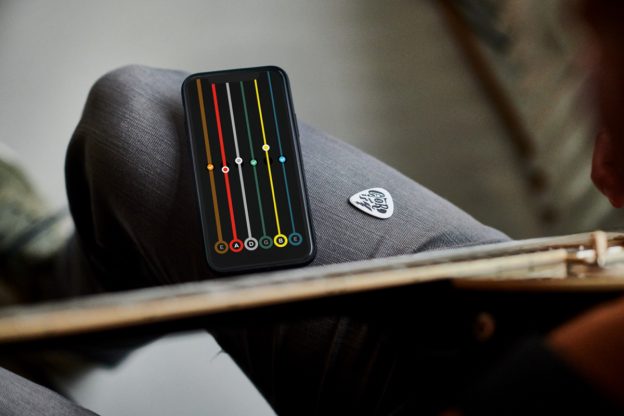Tuning your guitar is a skill that every player needs to acquire as soon as possible. No matter how good you are, no one sounds awesome on an out of tune guitar. In this blog post, we show you a few ways of tuning your axe.
If you’re just starting out on guitar, tuning isn’t always the easiest part. Moreover, it can feel like an annoying chore if you’re eager to start jamming. However, it’s important to regularly tune your instrument, not just for yourself but also for your neighbors!
This article is part of Chordify’s guitar tuning guide, in which you will find everything about alternate tunings like drop D tuning, open G tuning, etc.
In this blog post you will learn:
- Order of strings on guitar
- Why tuning is important
- Train your hearing
- How to tune a guitar with a tuner
- How to tune a guitar without a tuner
- Fifth fret method
- Tuning new strings
Order of the strings
So, here’s a few tips and tricks. There are many ways of tuning, but for now, we’ll focus on the standard way. That means going from the low E, the thickest string, to the high E, the thinnest string: E, A, D, G, B, E. You can easily remember this by the following mnemonic device: “Eddie Ate Dynamite Good Bye Eddie.”
You can make the strings sound lower and higher by turning the tuning pegs (also known as machine heads or tuning keys) located on the head of your guitar. It’s best to start with the low E string (the thickest one) and then working your way up to the high E string (the thinnest).

Why tuning is important
Not every string detunes equally quickly. There are some things that cause your axe to detune faster. For instance, differences in temperature or a new set of strings or… well, we could go on for pages listing reasons that will detune your guitar, but that’s just dull.
Fun fact about strings: They tend to return to the tension they were in the longest. That’s why tuning your guitar regularly trains the strings to “remember” their new tension. And that’s why new strings go out of tune very quickly. Just take it from us, tuning your guitar every time you pick it up is kind of a must.
Train your hearing
When you’re playing, you’re not just training your fingers to go where they should, you’re also training your ear. And because of that, it’s very important that you know what notes, chords and strings should sound like.
If you get used to playing out of tune, you’re training your ears to hear the wrong thing. After a while, notes that are out of tune will sound fine to you. And you don’t want that.
How to tune a guitar with a tuner
The easiest way of tuning your guitar is with a tuner. There’s a lot of versions of this device out there. From tuners you can use on your phone to pedals that fit neatly into your pedalboard. We’re going to zoom into the most common devices.
Tune with Chordify
Did you know Chordify has its own tuning option in the app? It’s a free multi-string tuner. You can use it to tune your strings separately and, when you strum all strings at once, it can also show you which strings are out of tune. Pretty nifty, right?
On the Chordify Android app, you can find the tuner option to the right of My Library.
On the Chordify iOS app, you can tap the Toolkit and then find the tuner at the top of the page.
Clip-on tuner
Besides tuning apps, tuners come in different shapes and forms. Regularly used electronic tuners are clip-on tuners for all guitar types (electric and acoustic). This device clips onto your guitar’s headstock, picks up the pitch of a string and tells you whether it’s too high or too low.
Built in tuner
Yet another option are integrated tuners, incorporated in the body of the guitar. There are also tuning devices that come in the form of pedals. They allow you to add a tuning option to your guitar pedalboard.
Pedal tuner
Lastly, a tuner can also be a device with a cable input, but not in pedal form. When you’re at home, this is fine. But, when you’re on stage, tuning your guitar with this tuner is far from ideal because you have to the cable in and out of the amplifier every time you tune your strings. That’s why most professional musicians use a tuning pedal.
How to tune a guitar without a tuner
There will be times when you won’t have a tuning device on you, so you’ll have to rely on your ears. The easiest thing to do is to tune your guitar with a piano or keyboard nearby.
Tune your guitar with a piano
Starting at the lower E string playing it together with the piano E key, then follow up with the A string together with the A key on the piano, and so on.
Tune by using a video
If you don’t have a piano you can use this tuning video.
Tuning by fork
Another way of tuning your guitar is to use a tuning fork, which can provide the sound of an A note (440 Hz). In this case you start by tuning your fifth string, the A string. Then you can match the other strings by using the fifth-fret method. Sounds complicated? Don’t worry, we’ll explain this old tuning technique in just a few steps.
Tuning your guitar with the fifth fret method
A guitar’s standard tuning has a neat feature that we’re going to exploit. A string pressed at the fifth fret sounds like the following string played open. In the image you see where to fret your string to match the note of the following open string. The low E string pressed at the fifth fret matches the open A string; the A string fretted at the fifth fret matches the open D string; and so on. Note the exception of the G string and open B.

Tuning new strings
Our last tip is definitely not the least important. It is crucial to remember that when you get new strings, you’ll have to tune your guitar more often. Boxfresh strings can still stretch out a little before they settle down on your trusty axe. One trick to make it a little easier: Each time you put a new string, grip it in the middle and carefully pull it upwards and then tighten it further.
If you repeat this a couple of times, your strings will have stretched a bit more and won’t untune as quickly. Strings tend to return to the tension they were in the longest. Our biggest tip is simply to tune every time you get your guitar out. The better it sounds, the more you’ll enjoy playing. And the more you enjoy playing, the better you’ll get. Happy jamming!



